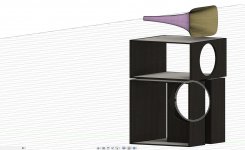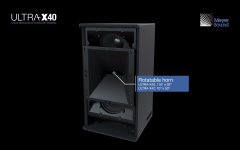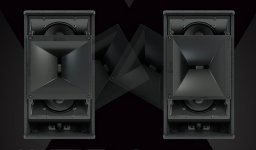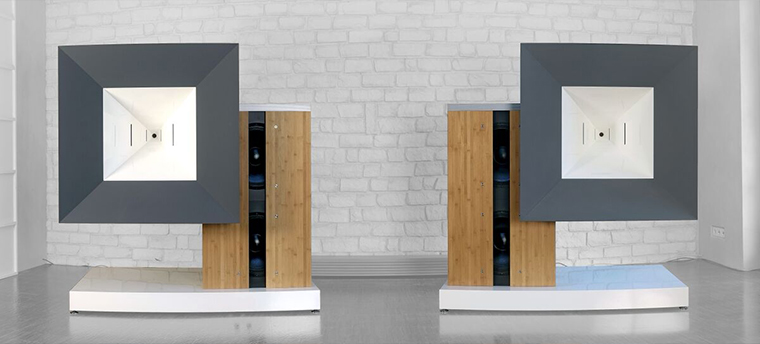Thank you for posting that again! While playing with slot loading, I had the thought, "that one guy told me about slot loading, but I couldn't model it right".....you are that "one guy" lol. Sorry, not the best memory.
My issue is what to do with the 2 18"s...Slot loading vertically, face to face, reduces their foot print. I can do that horizontally but that forces the distance from ear down a little and distance from the above source. In the near field, minute changes like this do make a difference, whether these specific changes are detrimental or not, I don't play that game, I just try and error towards SQ.
- you're a cheaterI made the slots V shaped and got the TD15s to play past 600 Hz.
My issue is what to do with the 2 18"s...Slot loading vertically, face to face, reduces their foot print. I can do that horizontally but that forces the distance from ear down a little and distance from the above source. In the near field, minute changes like this do make a difference, whether these specific changes are detrimental or not, I don't play that game, I just try and error towards SQ.
Last edited:
Just like but with a vertical slot. It is Djk, if I recall, who experimented with different slot width ratios, including 1:2.
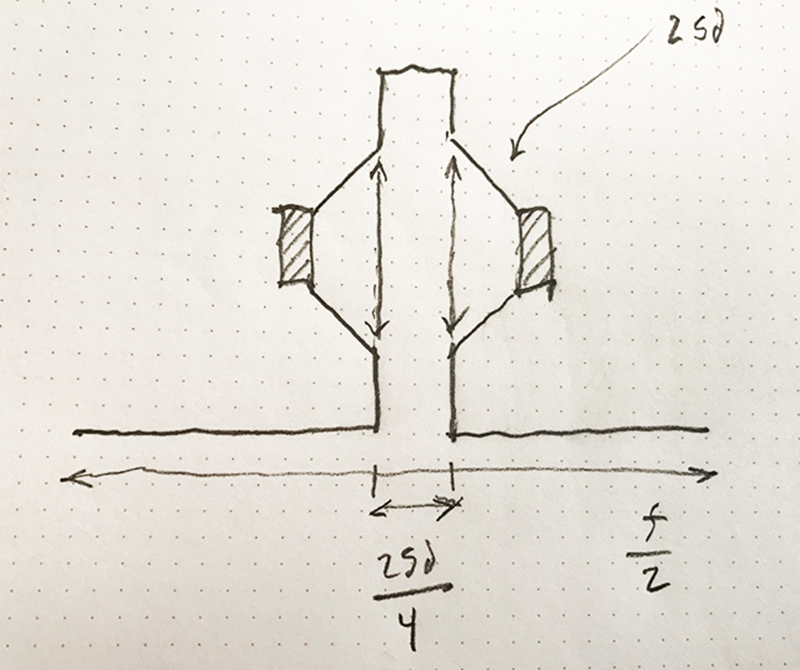
Here's the configuration I commonly come across showing 1:4 gaps are used too.
I haven't encountered any discussion about slot width vs diaphragm diameter before....or any ratio thereof...interesting...
I've always thought slot width is simply the width of the slot between the driver baffles...and that it's 1/4WL size is the upper end of usable response..
I just made it a front loaded horn with the initial CSA the height*width of the slot. length, the literal length of the slot, even though its not exact since a part of woofer is right at the mouth. To simulate pressure of anothger woofer firing at another, halve csa, for an estimation, I'd say.
I was hoping to get a passionate opposition so I could let them know how I told the make of the speaker how his 15H is a better suited subwoofer because someone told me so, and the maker said that they are wrong and the 18H+ is better than the 15H in everyway.
So would I do and trust John.
Just like but with a vertical slot. It is Djk, if I recall, who experimented with different slot width ratios, including 1:2.

Here's the configuration I commonly come across showing 1:4 gaps are used too.
I am not sure if somebody already mentioned the Ripol:
RiPol Subwoofer – RStAudio.de
You should consider the Ripol sub. It is a step further.
I am not sure if somebody already mentioned the Ripol:
RiPol Subwoofer – RStAudio.de
You should consider the Ripol sub. It is a step further.
increases directivity of direct energy? I can see that waves are focused like i thought they would. Can't go higher than 30hz but I see it at 30hz.
I view the line arrays, either CBT or straight, as different animals than the group of speakers I'd put in "point source" category. I kinda see them as sounding halfway towards an omni type sound. If i was into home theatre, I think the corner lines would work great both focus to a sweet spot and provide wider seating coverage.
The 15cxn88 coax is a nice sounding, fairly compact solution. I believe it and other prosound coaxs are best suited for musician's floor monitors.
Very close to hi-fi, but just not quite at the level of a separate horn and CD mated with whatever cone.
The 100Hz synergy, in it's last incarnation, a 60x40 sized for about 300Hz control, is the most gripping speaker I've built (or heard) yet.
It's just too damn big and heavy to move around like I like, so I'm currently working on lighter 90x60 build. The 90x60 allows a lighter box design, but so far it doesn't have quite the magic of the 60x40. I'll need to finish getting a secondary flare working on the new guy, to see if I can live with it.
Circling all the way back to my beginnings with DIY tops/mains....the Peter Morris PM90 and PM 60 are still two of my favorites, both indoors and out. I've used the 90 degree version for live events for several hundred or more folks, and they are very hi-fi. The MTM hornloaded 12"s around a CD, really works.
But so do other modular designs I've tried that use the same same CD & wavequide , but in separate boxes for the sections. Sometimes with one 12", sometimes with two.
I really think the most pragmatic way to get the SQ, dynamics, and SPL that I enjoy into one box, is some kind of MTM using a very good CD & waveguide.
I believe copying the new Meyer X-40 that uses a pair of 8"s in a simple MTM config would be a smart build.
Oh, and a biggie in all my DIYs, even including the line arrays...
everything gets a sub....all have been designed for 100Hz xover.
my 2 cent experiences...
Thx for this summary of your experiences with different loudspeaker systems. It's interesting and useful for those who consider building 1 or more of these concepts.
As for the Meyer Ultra X-40... Diffraction horn revival
Attachments
3db is a lot it is the same as doubling the power input, not easy to get and shows the difficulty in getting SPL low down it takes a lot of volume displacement.Only a 3db advantage over a midrange driver? Either the Ultimax is a below average subwoofer or the 18h+ is a super performing midrange that can do subwoofer duty.....hmmmm. I will say that a lot of the guys who critique this aspect, they have extension goals that are beyond mine....so its kinda like saying "thats not a knife.....this is a knife"
These are just comparisons the drivers were the ones you were comparing in your charts.
It's become quite difficult to know exactly what your goals are the posts have been moved a few times, even if they have ended up back at the same spot
My point was not to suggest that you seek 10Hz at 130dB but that 30Hz is still quite a high point to consider your lowest frequency of interest.
I think that with 30Hz F3 with a Q=0.7 slope in a sealed cabinet gives good low extension but allows higher spl's and more headroom.
SL's sub target was 20Hz and Q=0.5, that limits the SPL and headroom quite a lot more.
No suggestion was made that any driver would sound better or worse only that some drivers parameters make them more suitable for certain kinds of tasks. Maybe that has come through now.Can't argue that...THis is an aspect worth arguing -> 30hz on up duty...who sounds better? 18H+ does...
I will admit, the more I look at the chart above, the more I see where you guys are coming from. Yet I understand, and desire no change, is all.
Together, we can make this work, but slot loading is not going to make or break this design.
My point was not to suggest that you seek 10Hz at 130dB but that 30Hz is still quite a high point to consider your lowest frequency of interest.
I think that with 30Hz F3 with a Q=0.7 slope in a sealed cabinet gives good low extension but allows higher spl's and more headroom.
SL's sub target was 20Hz and Q=0.5, that limits the SPL and headroom quite a lot more.
30 Hz suffices for 95, probably 98% of all music ever recorded. In terms of impact, 30 Hz from an 18" or bigger Pro driver will trounce 20 Hz reproduced by 8 or 10" audiofoolish woofers. But as the saying goes: "You can't ever have enough (sub/infra) bass."
Last edited:
Also very true, quality is harder to achieve than quantity 
Live sound is quite different in approach to home or studio audio. Even though the speakers and drivers can be interchanged sometimes there are differences which are due to constraints the other doesn't have to suffer.
The size of a box is important to a live sound company that has to ship them in standardised containers. In a home it does not really matter if it is 20" or 20.5".
In live sound the weight of a box is a consideration as someone will have to keep moving it. In a home mostly not an issue.
In live sound it has to be loud, the louder it is the less boxes you need the cheaper it is the less effort it is.
None of that really matters as much in a home or studio so those constraints are not there and cutting sub 30Hz is not as good a trade at home or in studio as it is on the road.
The down side to this can be seen in home produced music where it was mixed and mastered by small speakers with no low bass ability. Everything below 60Hz is a total mess because they could not hear it (Headphones can help but are not a complete solution).
Live sound is quite different in approach to home or studio audio. Even though the speakers and drivers can be interchanged sometimes there are differences which are due to constraints the other doesn't have to suffer.
The size of a box is important to a live sound company that has to ship them in standardised containers. In a home it does not really matter if it is 20" or 20.5".
In live sound the weight of a box is a consideration as someone will have to keep moving it. In a home mostly not an issue.
In live sound it has to be loud, the louder it is the less boxes you need the cheaper it is the less effort it is.
None of that really matters as much in a home or studio so those constraints are not there and cutting sub 30Hz is not as good a trade at home or in studio as it is on the road.
The down side to this can be seen in home produced music where it was mixed and mastered by small speakers with no low bass ability. Everything below 60Hz is a total mess because they could not hear it (Headphones can help but are not a complete solution).
- I see your point. Why didn't you just say that lol! Go deeper?30Hz is still quite a high point to consider your lowest frequency of interest.
- I'm sorta doing that.Kind of my point, use the 18" relatively flat down to 30Hz and roll off sealed at Q 0.7. You get all those things together.
After seeing this you may want to say that I should just get rid of the 15"...but this can only be true if I can crossover low enough and thats not a guarantee. What woofer do you suggest btw? This is just the picture I could find, an example of what can be done, if you will...I remember playing with xover on the 15m and getting it so that it only touched something like 3mm of excursion at 115db....this might be modeled with just one 18..not that it makes a huge difference? I think qts suffered to .49?.....189l per 18.
Last edited:
I thought I did- I see your point. Why didn't you just say that lol! Go deeper?
I don't see the image it's gone somewhere..- I'm sorta doing that.
I would use multiple sealed woofers, (between 2 and 4) spread around at the best measured locations anywhere between 12" and 18" depending on the space and budget available.I noticed above it might look like I'm asking for a suggestion for the 15, I'm not. I'm asking for a reference to the woofer you'd use for the lowest woofer.
For myself I have bought 15" HF Reference Drivers as they go high enough to cross wherever I need and have enough Sd and Xmax to go much louder than anything else they will be used with and were available to me at a reasonable price. Not always the case in Australia. No refrigerator sized box or an amp to melt the house wiring needed either.
I really like the look of the B&C 18SW115 the motor on that driver is incredibly linear the klippel results are almost perfect. It models very similar to your TD18H+ (same Sd and xmax), the BMS 18nd driver also looks to be very good, but 18's are hard for most people to fit in multiples me included
Rss390hf
Another shout out from an armchair quarterback (no experience with it).
.707 sealed, vb 4.5ft3, f3 = 32hz.
200w, 108db at 14mm xmax at 32hz.
200w, 102db at 14mm xmax at 20hz.
I hadn't thought of it as a non sub, but i loved my magnum 15's run 750hz down (27hz tuned).
I don't know of an 18 sealed with f3 near 30hz, let alone call for sealed .707 less than 10ft.
B&c are pricy this side of the pond.
Norman
Another shout out from an armchair quarterback (no experience with it).
.707 sealed, vb 4.5ft3, f3 = 32hz.
200w, 108db at 14mm xmax at 32hz.
200w, 102db at 14mm xmax at 20hz.
I hadn't thought of it as a non sub, but i loved my magnum 15's run 750hz down (27hz tuned).
I don't know of an 18 sealed with f3 near 30hz, let alone call for sealed .707 less than 10ft.
B&c are pricy this side of the pond.
Norman
- Home
- Loudspeakers
- Multi-Way
- Is it possible to cover the whole spectrum, high SPL, low distortion with a 2-way?

